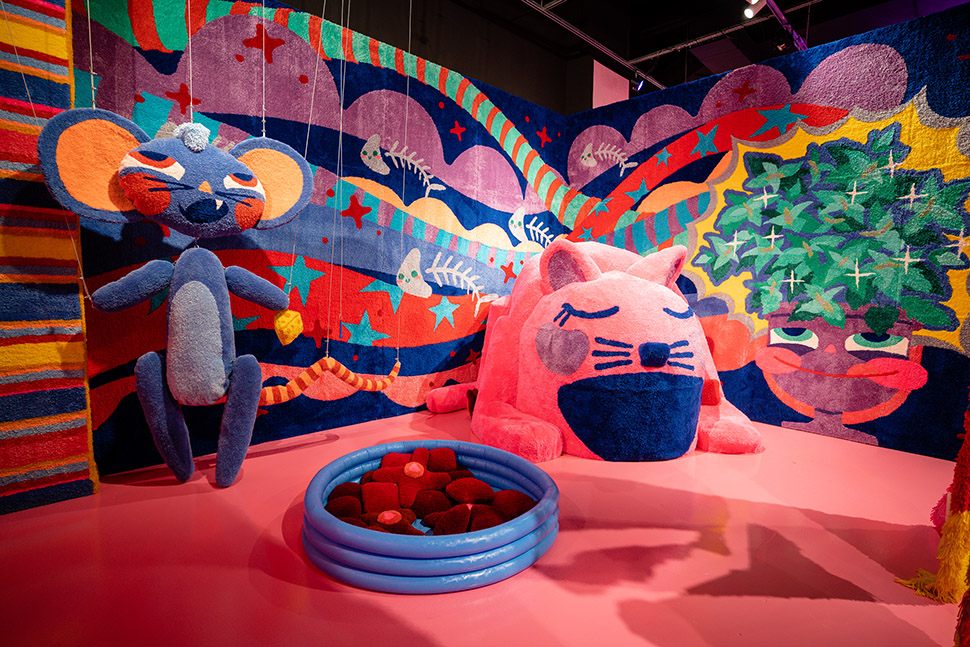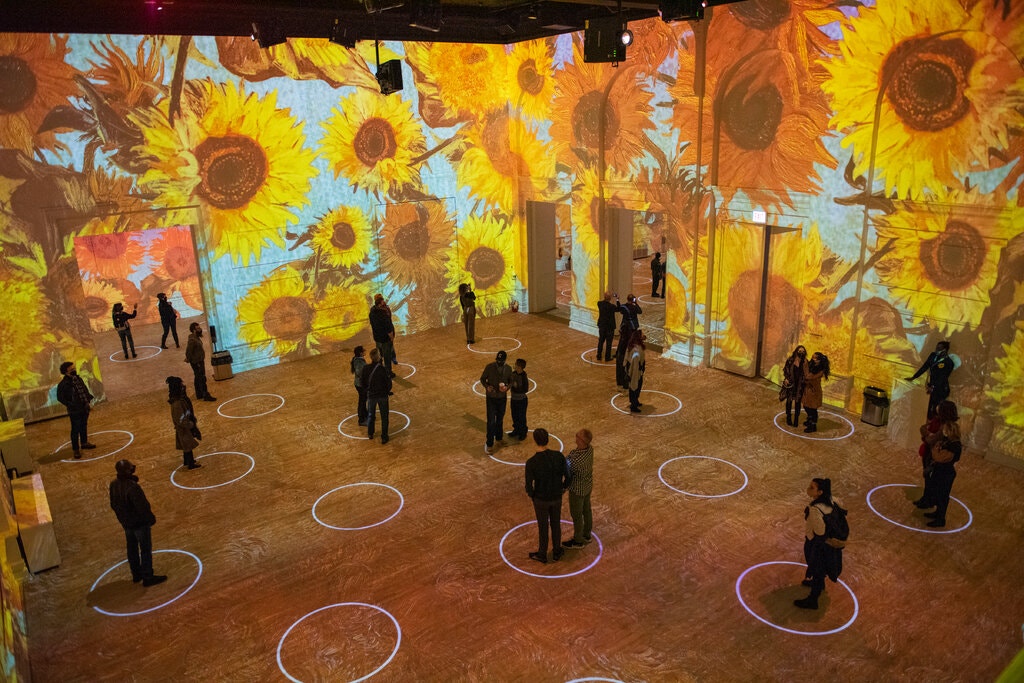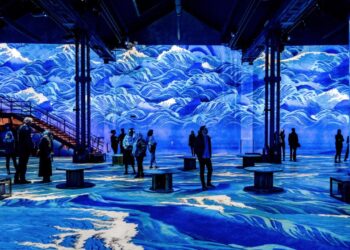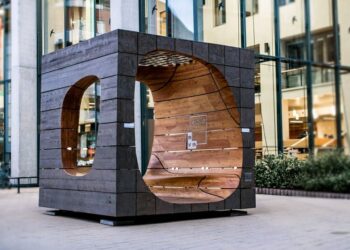In a world saturated with fleeting images and passive consumption, experiential art has emerged as a captivating force, profoundly influencing the broader design landscape. More than just visual spectacle, it invites active participation, transforming spectators into participants and creating unforgettable, multi-sensory encounters. This art form, often blurring the lines between physical and digital, challenges traditional notions of art appreciation by prioritizing immersion and interaction. This comprehensive article delves into the burgeoning impact of experiential art, exploring its historical lineage, the psychological underpinnings of its appeal, and its diverse manifestations across various design disciplines. We’ll uncover how designers are drawing inspiration from this immersive approach to craft environments, products, and brands that don’t just communicate, but truly engage and leave a lasting impression.
Tracing Experiential Art’s Roots

While the current wave of highly technological, immersive art feels contemporary, the essence of experiential art—involving the audience beyond passive observation—has roots stretching deep into art history.
A. Performance Art and Happenings (Mid-20th Century): Artists like Allan Kaprow in the 1950s and 60s created “happenings,” spontaneous events designed to involve the audience directly in the artistic act, often incorporating everyday environments and objects. This challenged the traditional gallery setting.
B. Installation Art (1960s onwards): Artists began creating large-scale, site-specific works that transformed entire spaces, immersing the viewer within the artwork itself. Think of Yayoi Kusama’s “Infinity Rooms” or James Turrell’s light installations, which manipulate perception.
C. Land Art (Late 1960s-1970s): Artists like Robert Smithson created monumental works directly within natural landscapes, requiring physical journeys from viewers to experience them. This emphasized the journey and the interaction with the environment as part of the art.
D. Early Interactive Digital Art (1980s-1990s): With the advent of computers, artists began experimenting with digital interfaces that responded to user input, creating early forms of interactive digital experiences, often seen in early multimedia installations.
E. Immersive Theater (Late 20th Century onwards): Productions like “Sleep No More” broke the fourth wall, allowing audiences to freely explore sets, follow characters, and forge their own narrative paths, highlighting the power of audience agency.
This historical lineage shows a consistent artistic drive to break free from passive viewing, pushing the boundaries of how audiences engage with creative expressions.
The Psychology of Immersion
The profound impact of experiential art stems from its ability to tap into fundamental human psychological needs and cognitive processes.
I. Active Participation and Agency
A. Sense of Control: Unlike passive observation, experiential art offers participants a sense of agency and control, allowing them to influence the outcome or progression of the experience. This empowers the individual.
B. Enhanced Memory Formation: Experiences that involve active participation, movement, and multi-sensory engagement are more deeply encoded in memory than those that are merely observed. The brain creates stronger neural pathways for active learning.
C. Personalized Journey: Because participants can often choose their path or interact in unique ways, the experience feels tailored and personal, leading to a stronger sense of connection and ownership.
D. Reduced Cognitive Load (Paradoxically): While seemingly complex, the immersive nature of experiential art can reduce external distractions, allowing participants to focus intensely on the present moment, leading to a state of “flow.”
Active participation transforms a passive viewer into a co-creator, amplifying engagement and memorability.
II. Multi-Sensory Engagement
A. Increased Sensory Input: Experiential art often engages multiple senses simultaneously—sight, sound, touch, sometimes even smell and taste—creating a richer, more holistic sensory experience that traditional art forms cannot match.
B. Emotional Response: Engaging multiple senses triggers more profound emotional responses. A combination of visuals, soundscapes, and tactile elements can evoke specific feelings more effectively than any single medium.
C. Deeper Immersion: When all senses are engaged, the distinction between the art and the viewer blurs, leading to a heightened sense of presence and immersion.
Multi-sensory engagement creates a more complete and powerful reality within the artistic space.
III. Social Connection and Shared Experiences
A. Facilitating Interaction: Many experiential art forms are designed for group participation, fostering social interaction, shared discovery, and collective emotional responses among participants.
B. Conversation Starters: The unique nature of these experiences often leads to spirited discussions, fostering social bonds and shared cultural references.
C. Community Building: Art installations that invite public interaction can become focal points for community gathering and shared cultural identity.
Experiential art fosters a sense of collective discovery, transforming individual engagement into shared social moments.
IV. Novelty and Surprise
A. Breaking Expectations: By moving beyond conventional art forms, experiential art often subverts expectations, creating moments of surprise and delight that capture attention and stimulate curiosity.
B. Discovery and Exploration: The open-ended nature of many installations encourages exploration and discovery, appealing to our innate human drive to learn and uncover new things.
C. “Instagrammability”: While not the primary goal, the highly visual and unique nature of experiential art often makes it highly shareable on social media, amplifying its reach and appeal. This taps into the modern desire for unique, shareable experiences.
The element of novelty ensures that experiential art stands out in a crowded media landscape, leaving a lasting impression.
Experiential Art’s Broad Influence on Design Disciplines
The core principles of experiential art are no longer confined to galleries; they are profoundly reshaping how designers approach spaces, products, brands, and even digital interfaces.
I. Retail and Commercial Design
Retail environments are increasingly leveraging experiential design to create memorable brand engagements that go beyond mere transactions.
A. Interactive Storefronts: Digital displays that react to passersby, inviting them into the store with personalized messages or dynamic visual content.
B. Brand Storytelling through Immersion: Retail spaces designed as immersive narratives, guiding customers through a brand’s history, values, or product benefits using multi-sensory elements (e.g., themed zones, soundscapes, interactive product displays).
C. Phygital Experiences: Blending physical retail with digital interaction, such as AR mirrors for virtual try-ons, QR codes triggering immersive product information, or interactive kiosks for customization.
D. Pop-Up Experiences and Brand Activations: Temporary, highly curated immersive spaces designed to generate buzz, provide unique brand interactions, and create shareable moments for marketing campaigns.
E. Sensory Marketing: Using scent, sound, and lighting strategically to create specific atmospheres that enhance the brand experience and influence purchasing decisions.
Commercial spaces are transforming into experiential destinations, offering entertainment and engagement alongside product offerings.
II. Hospitality and Entertainment Design
Hotels, resorts, and entertainment venues are embracing experiential design to create unique, memorable guest experiences.
A. Themed Environments: Hotels and resorts designed with immersive themes (e.g., a “space station” hotel, a “jungle” resort) where every detail, from room decor to dining, contributes to the narrative.
B. Interactive Installations in Lobbies/Public Spaces: Digital art installations, reactive lighting, or soundscapes in common areas that provide dynamic and engaging experiences for guests.
C. Personalized Guest Experiences: Leveraging smart technology to customize room ambiance (lighting, temperature, music) based on guest preferences, creating a feeling of bespoke luxury.
D. Immersive Dining Concepts: Restaurants that offer multi-sensory dining experiences, where projection mapping transforms tables, soundscapes enhance flavors, and interactive elements surprise diners.
E. Location-Based Entertainment (LBE): VR arcades, escape rooms, and interactive museums that provide highly immersive and collaborative experiences, often blending physical sets with digital content.
Hospitality design is moving beyond just comfort to offer guests unique, emotionally resonant journeys that stand out in a competitive market.
III. Museum and Exhibition Design
Museums are transforming from static repositories to dynamic, interactive learning environments, inspired by experiential art.
A. Interactive Exhibits: Hands-on displays, touchscreens, and motion-sensing installations that allow visitors to directly engage with content, making learning more active and memorable.
B. Immersive Storytelling: Using projection mapping, virtual reality, and surround sound to transport visitors into historical periods, natural environments, or artistic creations.
C. Personalized Paths: Digital guides or apps that allow visitors to curate their own experience, focusing on areas of interest and receiving tailored information.
D. Gamification: Incorporating game-like elements, challenges, and rewards to encourage exploration and deeper engagement with exhibition content, particularly for younger audiences.
E. Data Visualization Installations: Presenting complex data in an interactive and visually compelling way, allowing visitors to explore patterns and insights.
Museums are becoming vibrant learning spaces where visitors are invited to discover, interact, and forge personal connections with knowledge and art.
IV. User Interface (UI) and User Experience (UX) Design
The principles of engagement and immersion from experiential art are subtly influencing how we design digital interfaces.
A. Micro-interactions: Small, delightful animations and visual feedback for user actions (e.g., a button press animation, a “like” heart expanding) that enhance the sense of responsiveness and engagement.
B. Gamification of Apps: Incorporating rewards, progress bars, badges, and challenges to encourage continued use and engagement, inspired by game design principles.
C. Immersive Onboarding: Using engaging animations, short interactive tutorials, or personalized journeys to introduce new users to an app or website, making the learning process enjoyable.
D. Dynamic Data Visualization: Interactive charts, graphs, and dashboards that allow users to filter, drill down, and manipulate data, turning complex information into an explorable experience.
E. Narrative UI: Designing interfaces that guide users through a story or a specific workflow with a clear beginning, middle, and end, making complex tasks feel more manageable and engaging.
F. Emotional Design: Using color, typography, imagery, and animation to evoke specific emotions and create a positive, memorable user experience.
UI/UX design is striving to make digital interactions not just functional but also delightful, intuitive, and emotionally resonant, mirroring the engagement of experiential art.
V. Public Spaces and Urban Planning
Experiential art installations are increasingly being integrated into public spaces, transforming urban environments into dynamic, interactive landscapes.
A. Interactive Public Art: Sculptures or installations that respond to light, sound, touch, or movement from passersby, encouraging spontaneous interaction and play.
B. Projection Mapping on Buildings: Transforming static building facades into dynamic canvases for large-scale digital art, storytelling, or informational displays, creating immersive urban spectacles.
C. Urban Playgrounds and Installations: Designing public spaces with interactive elements (e.g., musical swings, light-up pathways) that encourage community gathering and playful engagement.
D. Smart City Interfaces: Interactive kiosks, digital signage, and public information displays that provide dynamic, real-time data and allow citizens to interact with urban services.
E. Soundscapes and Lightscapes: Curated auditory and visual environments that transform public spaces, creating different moods and experiences at various times of day or for special events.
Public spaces are becoming vibrant arenas for shared experiences, fostering community and a sense of wonder through integrated art and technology
Innovations Driving Experiential Design’s Influence

The rapid advancement of various technologies is crucial to the continued proliferation and sophistication of experiential design.
A. Advanced Projection Mapping and Immersive Screens: High-resolution projectors, LED screens, and flexible display technologies allow for seamless, large-scale visual immersion on almost any surface.
B. Real-time Graphics Engines (e.g., Unreal Engine, Unity): These powerful engines, traditionally used in gaming, enable the creation of highly realistic, interactive, and dynamic virtual environments that can be rendered in real-time.
C. Sensors and Tracking Technologies: Motion sensors, depth cameras (e.g., LiDAR), eye-tracking, and biometric sensors allow installations to respond intelligently and personally to participants’ presence and actions.
D. Artificial Intelligence (AI) and Machine Learning (ML):
* Generative Content: AI can create dynamic, ever-changing visuals, soundscapes, or narratives in real-time based on user input or environmental data.
* Personalization Algorithms: AI can adapt the experience based on individual participant behavior, preferences, or emotional responses.
* Natural Language Processing (NLP): Enables conversational interfaces within interactive installations, allowing users to engage through voice.
E. Augmented Reality (AR) and Virtual Reality (VR):
* Overlaying Digital on Physical: AR seamlessly blends digital content with the real world (e.g., through smartphone apps or AR glasses), creating interactive layers of information or fantasy.
* Creating New Realities: VR offers complete immersion in synthetic environments, allowing designers to build entirely new interactive worlds for entertainment, training, or artistic expression.
F. Haptic Feedback Technology: Devices that provide tactile feedback (vibration, pressure) enhance the sense of immersion and physical interaction within digital or simulated environments.
G. IoT and Connected Devices: The Internet of Things allows for seamless interaction between physical objects and digital systems, enabling complex, responsive environments where lighting, sound, and physical elements react to user presence.
These technological innovations are giving designers an unprecedented toolkit to create experiences that were once confined to the realm of imagination, making experiential art a powerful force for change in design.
Challenges and The Future of Experiential Influence
While the impact of experiential art is undeniable, its continued growth presents challenges and promises exciting future directions.
A. Cost and Scalability: Creating high-quality, technically sophisticated experiential installations can be expensive, limiting widespread adoption, especially for permanent installations.
B. Technological Obsolescence: As technology rapidly evolves, maintaining and updating interactive installations can be a challenge, risking quick obsolescence.
C. Accessibility and Inclusivity: Ensuring that these experiences are truly accessible to people with diverse abilities (e.g., visual impairments, mobility issues) requires thoughtful design from the outset.
D. Data Privacy and Ethics: Installations that collect user data raise concerns about privacy and how that data is used, requiring transparent policies and ethical design.
E. Measuring Impact Beyond “Likes”: While highly “Instagrammable,” quantifying the deeper impact and return on investment (ROI) beyond social media buzz can be challenging for commercial applications.
F. Balancing Spectacle and Substance: There’s a risk that the “experiential” aspect becomes a superficial gimmick without deeper artistic or communicative substance.
The future of experiential art’s influence on design is dynamic and promising.
G. Everyday Immersive Environments: The principles of experiential design will become more integrated into daily life, making our homes, workplaces, and public spaces more responsive, personalized, and engaging.
H. Emotional and Therapeutic Design: Leveraging experiential design to create environments specifically tailored to enhance well-being, reduce anxiety, or even aid in therapy, using light, sound, and interactive elements.
I. AI as a Creative Collaborator: AI will not just power the interactions but also co-create the content of experiential designs, generating unique narratives, visuals, and soundscapes in real-time based on user interaction.
J. The Blurring of Disciplines: The lines between art, design, technology, and science will continue to blur, fostering truly interdisciplinary approaches to creating immersive experiences.
K. Sustainable Experiences: Innovation in energy-efficient displays, reusable materials, and modular systems will make experiential installations more environmentally friendly.
Conclusion
Experiential art is more than a fleeting trend; it represents a fundamental shift in how we engage with creative expressions and designed environments. By prioritizing active participation, multi-sensory engagement, and personal connection, its influence will continue to shape a future where our spaces, products, and brands are not just seen, but truly felt and remembered.







Discussion about this post